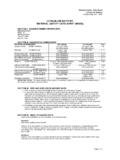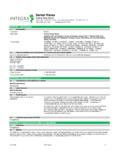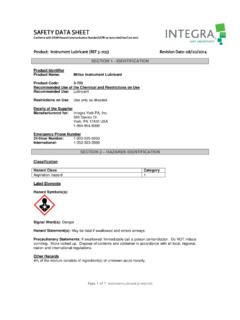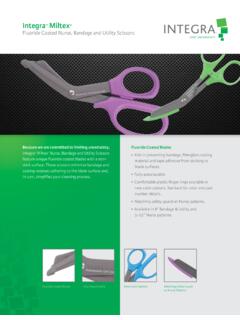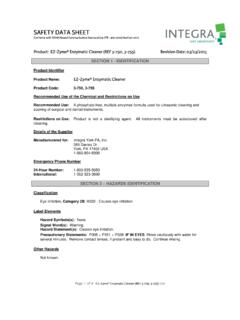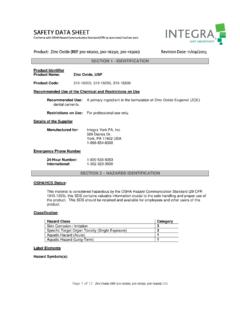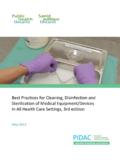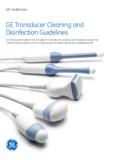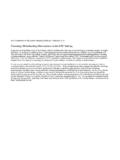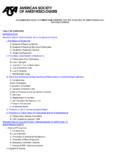Transcription of RECOMMENDED STEPS IN CLEANING, …
1 1. HOLDING/PRESOAKIt is important never to hold instruments in a dry container, whichallows blood and debris to dry onto instrument surfaces andmakes cleaning more difficult. If rinsing and decontaminationprocesses are not immediately available, pre-treat instrumentsor hold them in a neutral pH holding/presoak enzymatic solutionafter patient use but before actual cleaning . Miltex InstrumentPrep Enzyme Foam (3-760) is a ready to use foaming spray forpre- cleaning of soiled instruments and scopes. Simply spray oninstruments until ready for rinsing and disinfection. Also, MiltexEZ-Zyme (3-750 and 3-755) neutral pH all purpose multi-enzymeconcentrate is ideal for instrument presoaking and soon as possible, rinse, disinfect and clean as follows:2.
2 RINSINGI mmediately after surgery, remove organic materials by rinsinginstruments under warm (not hot) running water. Rinse shouldremove most blood fluids and tissue. Do not process dissimilarmetals (stainless, copper, chrome plated, etc.) together. Alwayswear safety protection DISINFECTING To protect medical personnel from contamination duringcleaning, immerse instruments completely in an EPA approveddisinfectant for approximately 10-20 minutes. Always closelyfollow manufacturers RECOMMENDED disinfecting time andsolution preparation instructions. Then rinse : Disinfected instruments are NOT STERILE. Neverexpose stainless steel instruments to bleach or other corrosivechemicals to disinfect. Exposure to bleach may result ininstrument pitting and will void all manufacturer CLEANINGAll blood, dried body fluids and tissue should be completelyremoved from the instruments prior to sterilization .
3 Severalmethods are Soak: An enzymatic cleaner bath (soak) such as MiltexEZ-Zyme (3-750 and 3-755) or a solution of water andneutral pH (7) detergent such as Miltex SurgicalInstrument Cleaner (3-720, 3-725 and 3-726) are effective inremoving organic material from instruments. Use distilled(demineralized) water if possible. Instruments should befully submerged for at least 10 minutes. Do not let"sharps" (scissors, knives, osteotomes, etc.) touch eachother and also be sure dissimilar metal instruments areseparated. Rinse instruments under running water toremove solutions. Change solutions Ultrasonic cleaning : Most instrument manuf acturersrecommend ultrasonic cleaning as the most effective wayto clean surgical instruments, particularly those withhinges, box locks, and other moving parts.
4 All instruments must be fully submerged in open distilled (demineralized) water if possible. Makesure that "sharps" blades do not touch otherinstruments to prevent possible surface scratching andalso be sure dissimilar metal instruments are separated..Process instruments for full RECOMMENDED ultrasoniccleaning cycle. Change solution frequently, or as oftenas the manufacturer instruments with water to remove the cleaningsolution. Miltex EZ-Zyme (3-750 and 3-755) or MiltexSurgical Instrument Cleaner (3-720, 3-725 and 3-726) canbe safely used with all ultrasonic Automatic Washer Sterilizers: Follow manufacturers recommendations but ensure instruments are lubricatedafter the last rinse cycle and before the sterilization :: Needle holders and forceps may crack ifsterilized with ratchet in closed cleaning : If ultrasonic cleaning is not available,observe the following STEPS .
5 Use stiff nylon cleaning brushes (3-1000). Do not usesteel wool or wire brushes except specially recommendedstainless steel wire brushes (3-1001) for instrumentserrated areas, bone files, burs or on stained areas ofknurled handles..Use only neutral pH (7) detergents such as MiltexSurgical Instrument Cleaner (3-720, 3-725 and 3-726). Ifnot rinsed off properly, low pH (acidic - less than 6 pH)detergents break down the stainless protective surfaceresulting in pitting and/or black staining. High pHdetergents (alkaline - more than 8 pH) can cause brownstains (phosphate surface deposit) which can alsointerfere with the smooth operation of instruments. Mostbrown stains are not rust and are easily removed withMiltex Surgical instrument Stain Remover (3-740).
6 Brush delicate instruments carefully, and if possible,separate them from general sure instrument surfaces are visibly clean and freefrom stains and tissue. Miltex Surgical Instrument StainRemover (3-740) can help remove residue stains. This isalso a good time to inspect each instrument for properfunct ion and condit ion..Check scissors blades to ensure proper function. Bladesshould glide open and closed smoothly. Test cuttingperformance at 3/4 length of the blade with the followingrecommended materials. Scissors should cut all the wayto the tips. RECOMMENDED cutting test materials: Fine/Delicate scissors: Surgical glove Medium scissors: Single layer of stocking/cast netting Large/Utility scissors: Double layer of forceps (pickups) for proper jaw alignment.
7 Teethmust meet properly - without hemostats and needle holders to ensure jaw tipsclose in first ratchet position and entire jaw should closein third ratchet position. Check instruments for loosehinges and verify that they lock and unlock easily. Alsocheck instruments for wear on jaw STEPS IN CLEANING, sterilization & MAINTENANCEOF SURGICAL INSTRUMENTS 7. CHEMICAL/COLD STERILIZATIONMost chemical/cold sterilization solutions render instrumentssterile only after 10-hour immersion. This prolonged chemicalaction can be more detrimental than the usual 20-minuteautoclave cycle. If the instruments need to be "disinfected" only, achemical/cold sterilization soak is acceptable, as disinfection willtake approximately 10 minutes or more.
8 Check manufacturers specifications. Also see our warning in using bleach (paragraph 3).Keep in mind the difference between:.Sterile - an absolute term (no living organism survives).Disinfected - basically clean. Some organisms may use the proper sterilization / cleaning technique torender the instrument in the required condition for :For instruments with tungsten carbide insert jaws,we do not recommend use of chemical/cold sterilizationsolutions, which may deteriorate the instrument s proper instrument care we recommend these Miltexproducts to safeguard and care for your quality STEPS IN CLEANING, sterilization & MAINTENANCEOF SURGICAL INSTRUMENTS phone 717 840-9335toll free 866 tubes should be clean Biopsy Punches by punching a clean hole in 3-6 milthick poly-bag material.
9 If poly-bag material is notavailable, use tissue should function edge instruments and knives should be sharpand free of scrubbing, rinse instruments thoroughly underrunning water. While rinsing, open and close scissors,hemostats, needle holders and other hingedinstruments to make sure the hinge areas are rinsed outand no debris AFTER CLEANINGS eparate dissimilar metals prior to sterilizing/autoclaving. Ifinstruments are to be stored, let them air-dry and store them in aclean and dry AUTOCLAVINGA. Lubricate all hinged instrumentswhich have any"metal to metal" action, at the screw or box lock. A non-silicone, water-soluble surgical lubricant such asMiltex Lube (3-700 or 3-705) is RECOMMENDED . Do not use industrial oils or Sterilize instrumentseither individually or in Instruments: Disposable paper or plasticpouches are ideal.
10 Make sure to use a wide enoughpouch for instruments with ratchet locks so instrumentscan be sterilized in an open (unlocked) locked during autoclaving can experiencecracked hinges (box locks) or other problems becauseof heat expansion. If wrapping instruments, make surethe towel does not contain detergent residue, which canstain Sets:Unlock all instruments and sterilizein an open position. Place heavy instruments on thebottom of set (when two layers are required). Do notoverload the chamber because an air pocket may formthat hinders steam :: With most portable tabletop autoclaves, at theend of the autoclave cycle and before the drying cycle, unlockthe door and open it no more than a crack, about 1/4" ( mm).
